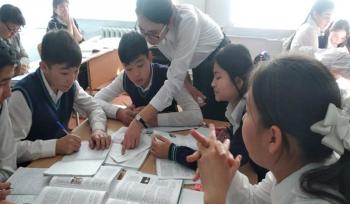Student of specialty 5В011000 - “Physics” Talip Dinara undergoes pedagogical practice
- 74 views
From 01/27/20 to 04/04/20 classes of Talip Dinara, a 4th year student of physics at the MSO "Gymnasium-gymnasium of Boyinsha1" under the updated program of teaching practice.
According to the updated program, the student was able to better organize the topic of the lesson, learning objectives based on the lesson, values, interdisciplinary communication, prior knowledge, planned stages of the lesson. During the lesson, questions with homework were asked using cutouts. Asked questions about the characteristics of sound, what we need to know about infrasound and ultrasound, what is echo.
In explaining the new lesson, we used new physical terms related to the topic of the lesson, using trilingualism.
Electromagnetic field - electromagnetic field-electromagnetic field
Electromagnetic wave-electromagnetic waves-electromagnetic waves
Intensity - Voltage
Induction Vector - Induction Vector - Induction Vector
Vacuum - Vacuum - Vacuum
The propagation velocity of an electromagnetic wave - the propagation velocity of electromagnetic waves - the propagation velocity of electromagnetic waves
Energy - Energy - Energy
Period - Period - Period
Oscillation frequency is the oscillation frequency
Inductance - Inductance - Inductance
In the middle of the lesson, electromagnetic waves are waves in which the electric and magnetic fields between the two wires that make up the communication circuit are in contact with each other in a certain amount of electromagnetic energy.
A summary of Maxwell's theory of electromagnetic fields:
1. An alternating magnetic field creates an electric field that changes in space.
2. An alternating electric field creates a changing magnetic field in space.
Variable electric and magnetic fields are always in contact with each other, so the unit of separation is called the electromagnetic field.
To visualize an electromagnetic field, it is described, on the one hand, by the electric field voltage vector, and on the other, by the magnetic field induction vector.
The spatial distribution of an alternating electromagnetic field is called an electromagnetic wave. Properties of electromagnetic waves: electromagnetic waves can propagate in various substances, even in a vacuum; electromagnetic waves are only shear waves.
The speed of electromagnetic waves in vacuum is 3 ∙ 108 m / s.
Electromagnetic waves carry energy. The propagation velocity of electromagnetic waves in a substance is lower than in a vacuum, and is determined by the following formula.
Scale of electromagnetic waves. Radio waves, microwaves, infrared waves, white light, ultraviolet waves, x-rays, gamma rays.
Light dispersion has two meanings: 1 - the phenomenon of complex separation of the white spectrum, 2 - the dependence of the refractive index of a substance on the wavelength of incident light.
Scheduled tasks associated with the new lesson are outlined. Exercise reports related to the assignment are issued.
During the lesson approval, thematic questions on the “snowball method” were prepared on the cutouts.
Pupils in the basket of knowledge: I understood very well, I was interested (Red basket); I well understood the lesson (Blue basket); I have yet to search by topic (Yellow basket), - rated themselves in baskets.
In conclusion, we hope that in the future, Talib Dinara will become a specialist in physics.
Authors: Candidate of Pedagogical Sciences, Associate Professor TD Berdalieva, Ph.D., Senior Lecturer MB Dinasilova

